Basic definition of kick pass
The kick pass, also known as the kick out pass, features action that generally occurs when an offensive player in possession of the basketball while already near the basket or at least moving towards it, throws it to a teammate who is near one of the perimeter areas of the court.
Basic kick pass examples
This section contains basic diagram examples featuring the kick pass used by offensive players.
Additionally, each of the offensive and/or defensive players on any diagrams below are generally represented by the standard basketball positions, unless otherwise noted.
In essence, 1 and X1 are the offensive and defensive point guards, respectively.
2 and X2 are the offensive and defensive shooting guards, respectively.
3 and X3 are the offensive and defensive small forwards, respectively.
4 and X4 are the offensive and defensive power forwards, respectively.
5 and X5 represent the offensive and defensive center positions, respectively.
Example 1: Kick out to corner
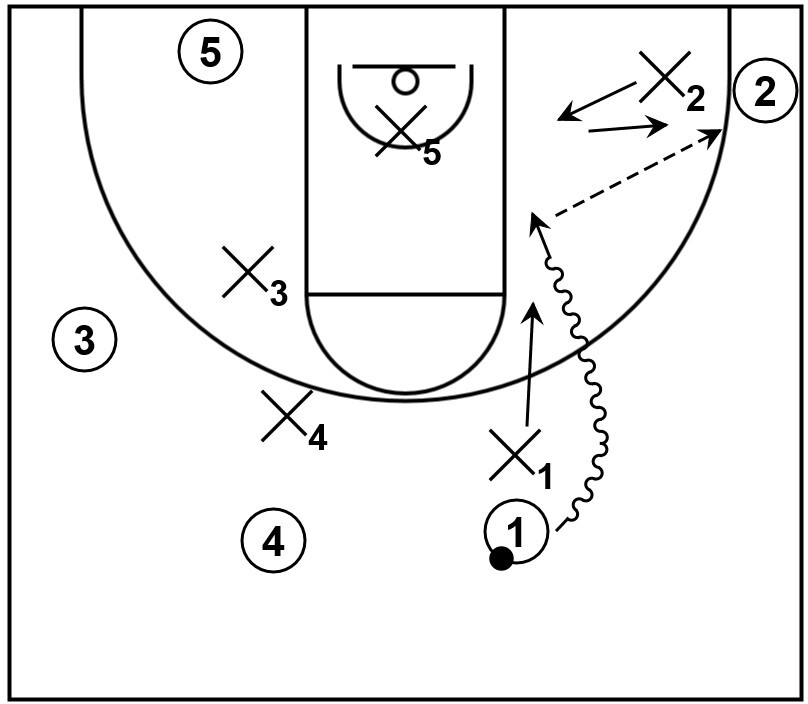
In reference to this example, 1 starts off near the right slot with possession of the ball, indicated by the black dot. From there, 1 beats X1 off the dribble and begins to drive towards the basket, represented by the wavy arrow.
While X1 chases behind, X2 stunts at 1 in an attempt to slow down the dribble penetration that is happening while X5 protects the rim.
From there, as a counter to the stunt tactic, 1 executes a kick pass towards the right side corner with 2 as the recipient.
Example 2: Kick out to the top
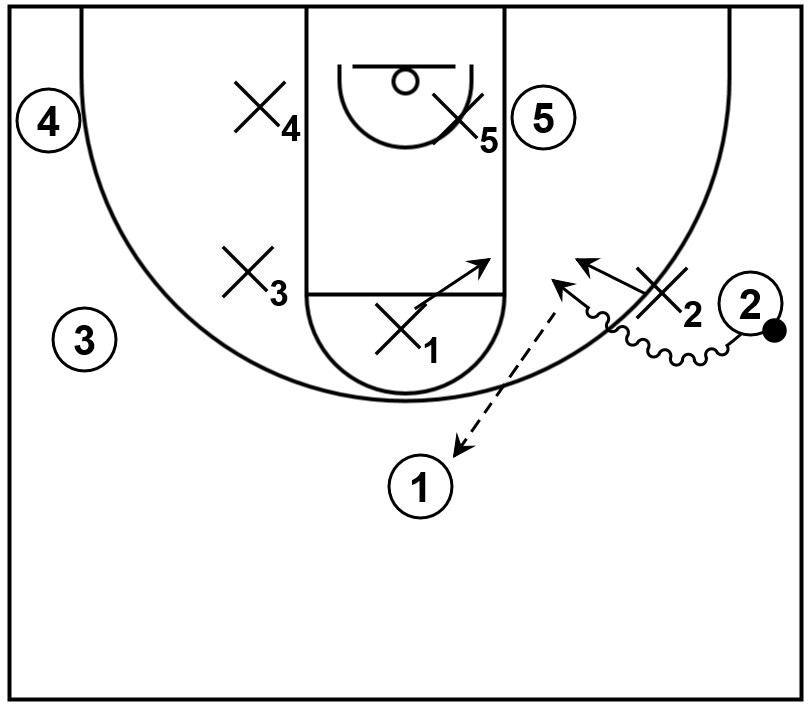
For this example, 2 starts off near the right side wing with possession of the ball. Afterwards, 2 beats X2 off the dribble and drives towards the middle of the lane.
This influences X1 to drop back to provide off-ball help defense, mainly to slow down the dribble penetration. As a result, 2 kicks the ball out with 1 as the receiver of that pass.
Example 3: Kick out to corner or wing
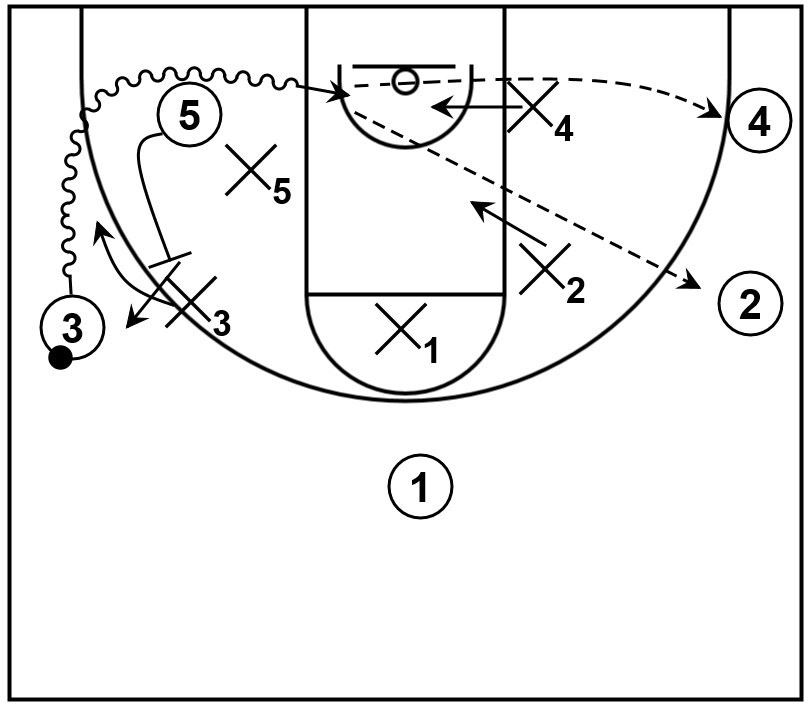
For this basic example, 3 begins with possession of the ball near the left side wing. Next, 5 lifts up toward that same wing to set a step-up screen.
Following that, 3 uses that screen and quickly drives baseline while X3 fights over the screen and 5 pops to the vacant wing.
Next, due to the dribble penetration, X4 as well as X2 collapse into the lane, ultimately to try and prevent a high percentage field goal such a layup at the rim.
Therefore, as a response, 3 has the option to throw the kick pass, which is also a drift pass in this instance, with 4 or 2 as possible receivers, respectively.
Affiliate Disclosure: I may earn a commission on qualifying purchases made through the links below.
Kick pass basketball drills
Drill 1
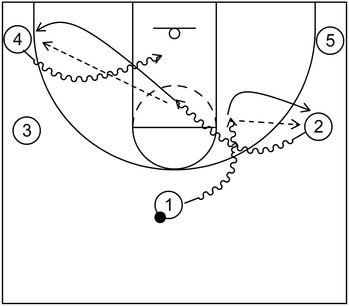
This is an example of a kick pass drill with an alignment that is similar to the 5 out motion offense.
Also, for this drill and any additional ones, offensive and defensive players do not have specified roles and are simply denoted as 1, 2, 3, X1, X2, etc.
To start the drill, 1 dribbles toward the basket and then 2 receives the ball via the kick pass from 1.
Following that, 2 dribbles towards the basket while 1 fills the vacated spot near the right side wing.
Afterwards, 4 receives the ball from 2 via a kick pass and then dribbles toward the basket to score at the rim while 2 fills the empty left side corner.
It should also be noted that when executing the drill, players should try to kick pass laterally or kick ahead.
Generally speaking, for the purposes of this drill, players should not turn and pivot to pass directly behind them.
It is also recommended that players execute at least three kick passes before taking a jump shot or layup.
It should be mentioned as well that to make the drill more challenging if necessary, it is possible to add defensive players.
Conversely, if the drill was to also include defenders and specifically, five defenders, then players would generally dribble, penetrate, and kick out until an open shot becomes available.
A similar drill to that end could be observed in My Favorite Drills for Basketball Practice by Nathan Davis.
Related: Kick Out Basketball Drill for Penetration – YouTube
Drill 2
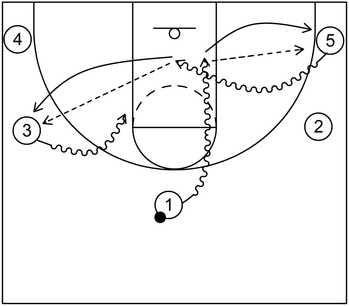
This is another example that is somewhat similar to the previous drill involving the kick pass. This time, however, 1 dribbles toward the basket and then 5 receives the ball via a kick pass from 1.
Next, 1 follows behind 5 to fill the vacant right side corner while 5 dribbles towards the rim. Afterwards, 3 receives the ball via a kick pass from 5 and then, 3 dribbles toward the high post area.
Following that action, 5 fills the vacant left side wing while 3 takes the mid-range shot.
Additional insights about the kick pass
Typical time kick pass gets utilized
The kick pass is generally used after dribble penetration, especially near or within the lane area.
However, it could also be carried out by a player who receives the ball after initially cutting to the basket or by an offensive player near a low post area who would be in current possession of the ball.
In essence, the player cutting to the basket could receive the ball and then immediately kick it to another teammate, especially as a counter to off-ball help defense.
In terms of the low post player in possession of the ball, the kick pass may occur as a response to a double team or some other defensive tactic, which could hinder low post productivity and/or efficiency.
The kick pass is also commonly utilized within the dribble drive motion offense, primarily due to the drive and kick action.
General reason why kick pass is potentially effective
The kick pass is potentially effective because it can create scoring opportunities, especially from three-point range or even additional offensive playmaking opportunities such as more ball movement, particularly around the perimeter or dribble drive action towards the basket.
As a brief example, let say that an offensive player in possession of the basketball is able to get around the on-ball defender who is currently guarding them and move towards the basket with dribbling moves or with a tactic such as the pick and roll action.
When that typically occurs, it generally influences the other off-ball defenders to rotate with help defense, particularly by sliding towards the ball and/or towards the basket.
When the defensive rotation occurs, the offensive player in possession of the ball could then execute a kick pass towards the perimeter, which could then lead to a possible open jump shot or some other type of playmaking action.
Related: The Kickout Pass May Be the Most Important Pass in the NBA – NBA.com